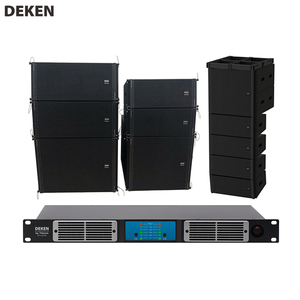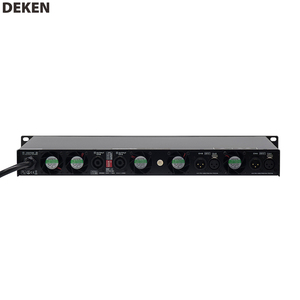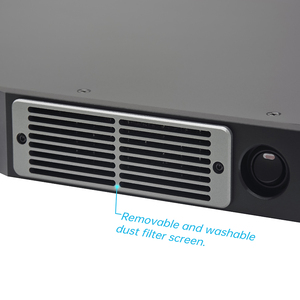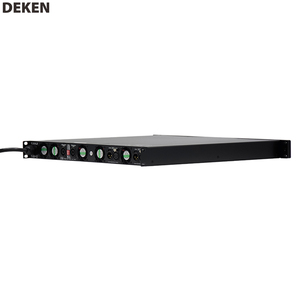(5382 products available)

































































































































































































A line array power amplifier enhances and boosts the power of audio signals to provide high-output power for line array speakers. This amplifier is designed to work with line array speaker systems, which consist of multiple speakers in a horizontal or vertical line configuration.
The aim of these amplifiers is to provide a clean and powerful output that can drive the line array speakers to their maximum potential while maintaining clarity and fidelity. Line array power amplifiers typically have multiple channels to drive each individual speaker in the line array. They also often have built-in processing capabilities, such as crossover functions, equalization, and limiting, to optimize the amplification for the specific line array configuration.
It ensures that the audio signals are amplified and delivered with maximum volume and clarity. There are different ways of classifying line array amplifiers; each shows a different classification:
The line array power amplifier functions by boosting low-level audio signals from sound sources like microphones and mixing desks to sufficiently loud levels to drive a line array speaker. When selecting an amplifier for line array speakers, consider features like protection circuits, Bridge Mode, control settings, and digital inputs.
Protection Circuits
Pro audio amplifiers require robust protection circuits to safeguard against potential damage from excessive current or voltage, temperature increases, and short circuits. Many modern power amplifiers have advanced protection circuits that can detect and prevent damage from these risks. Some also have RF filtering to eliminate interference from mobile phones and other devices.
Bridge Mode
Bridge Mode s amplifiers allows two amplifiers to be combined to increase the power output by a factor of four. Line array speakers often need high power, so amplifiers with a Bridge Mode feature are popular because of their ability to drive the speakers with the required power output.
Control Settings
Another important feature of modern amplifiers is remote control capabilities. With control settings on the front panel, a computer, or a smartphone, sound engineers can more easily adjust settings and optimize the performance of line array speakers. These features may include equalizer functions, crossover control, limiting, and dynamic headroom.
Digital Inputs
Amplifiers for line array speakers more often have digital inputs like Dante and AES/EBU to accommodate the growing demand for digital signal processing. These inputs provide high-fidelity signal transfer over long cable runs without interference.
Line array power amplifiers offer a lot of versatility, which means that they are suitable for many different application uses. Here is a look at some of the more common uses:
Concerts and event sound reinforcement
Line array power amplifiers are regularly used for concerts, events, and large shows. They create a scalable sound system that provides consistent coverage and high output for all events of this nature.
Permanent installations
These line amplifiers are frequently installed in convention centers, arenas, stadiums, auditoriums, houses of worship, and other locations needing a sound system of this caliber.
Corporate AV
The amplifiers are great for AV setups because they offer clear audio for conferences, corporate events, exhibitions, breakout rooms, and other business functions.
Touring sound
These line array amplifiers are rugged and can withstand the demands of touring. They can be used for broadcasts, live musical shows, and other events that need sound systems to be transported.
Production audio
Film and TV productions can rely on these amplifiers for location sound, special events, interviews, and other scenarios needing clear audio capture and distribution.
Architectural soundscapes
Line array amplifiers can blend into their surroundings since they have a very low visual impact. This makes them useful for creating immersive audio experiences in museums, theme parks, retail spaces, and other environments.
Distributed audio systems
For applications needing multiple listening zones or coverage areas, these amplifiers are great because they provide a consistent and balanced audio across a wide area.
Stavoline Array Power Amplifiers are crucial for delivering line array speakers at high power levels without distortion. When selecting amplifiers for a line array system, it is essential to consider the following factors:
Power Handling
An amplifier's capability to drive a speaker depends on its output power. Therefore, finding an amplifier with sufficient power output to drive the line array speakers to the required maximum volume level is essential. This will ensure the speakers perform optimally without damaging them due to underpowering or overpowering. Additionally, it is necessary to consider an amplifier with headroom to spare above the power handling capacity of the speakers. This will provide enough dynamic peaks of power without reaching the maximum power limit.
Channel Configuration
Another essential factor to consider when selecting an Amplifier is channel configuration. A two-channel amplifier can be enough for a simple setup providing independent power to each speaker. However, larger systems may require multi-channel amplifiers with more than four channels. Multi-channel amplifiers simplify wiring and reduce the number of devices that must be powered and installed for systems that have several identical line array speakers.
Output Equalization and Crossover
For optimal integration with subwoofers and to tailor the amplifiers output to the speakers frequency response, many amplifiers include built-in digital signal processing (DSP). DSPs allow for fine-tuning of frequency response through equalization. They also facilitate crossover functions that ensure proper matching between amplifiers and line array subwoofer speakers.
Protection Features
When selecting a line array amplifier, it is essential to consider the protection features it has. Protecting an amplifier can significantly improve the device's durability, thus reducing repair costs and ensuring a stable, error-free music production. For instance, protection features such as thermal protection and short circuit protection help prevent an amplifier from damaging due to excessive heat or a fault condition.
Impedance
The impedance of a speaker is a resistance value that indicates how much load the amplifier has to drive. Therefore, selecting an amplifier whose rated output power matches the speaker's impedance value is essential. The amplifier's impedance has to be compatible with the speakers for optimum power and best sound quality.
Q1: What is a line array power amplifier?
A1: A line array power amplifier is specifically built to drive the high- and low-frequency transducers in line array loudspeakers. These amps usually have more power output and more channels than regular amps.
Q2: Why do line array speakers need special amps?
A2: Line array speakers have multiple small drivers that need separate channels of amplification. The amplifiers also often include DSPs with EQs and crossovers tuned to the specific cabinet design.
Q3: Can I use a regular amplifier for a line array speaker?
A3: It is technically possible to use a regular amplifier to run a line array speaker, but it is not recommended. Line array speakers require precise amplification to deliver optimal sound quality and volume levels.
Q4: How powerful does an amplifier need to be for a line array speaker?
A4: The power requirements depend on the speaker's sensitivity and the maximum volume level needed. Amplifiers rated from a few hundred watts to several thousand watts per channel are common for line arrays.